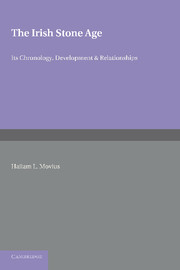Book contents
- Frontmatter
- Dedication
- Contents
- ILLUSTRATIONS
- FOREWORD
- PREFACE
- INTRODUCTION
- Part One THE CHRONOLOGY OF THE LATE-GLACIAL AND EARLY POST-GLACIAL PERIODS IN NORTHERN AND WESTERN EUROPE
- Part Two THE STONE AGE CULTURES OF IRELAND
- Appendices I-VI
- APPENDIX I The Raised Beach of the Third Interglacial Period
- APPENDIX II Deposits of the Interstadial Period between the Old and the New Drift Glaciations (W1/W2) in England and Scotland
- APPENDIX III The New Drift Glaciation
- APPENDIX IV The Recession of the Last Ice-Sheets
- APPENDIX V Deposits of the Late-Glacial Sea
- APPENDIX VI Submerged Forests and Raised Beaches in Britain and Ireland
- REFERENCES CITED IN THE TEXT
- CLASSIFIED LIST OF REFERENCES TO CAVE RESEARCH AND STONE AGE ARCHAEOLOGY IN IRELAND
- ADDENDUM
- INDEX
APPENDIX VI - Submerged Forests and Raised Beaches in Britain and Ireland
from Appendices I-VI
Published online by Cambridge University Press: 05 June 2016
- Frontmatter
- Dedication
- Contents
- ILLUSTRATIONS
- FOREWORD
- PREFACE
- INTRODUCTION
- Part One THE CHRONOLOGY OF THE LATE-GLACIAL AND EARLY POST-GLACIAL PERIODS IN NORTHERN AND WESTERN EUROPE
- Part Two THE STONE AGE CULTURES OF IRELAND
- Appendices I-VI
- APPENDIX I The Raised Beach of the Third Interglacial Period
- APPENDIX II Deposits of the Interstadial Period between the Old and the New Drift Glaciations (W1/W2) in England and Scotland
- APPENDIX III The New Drift Glaciation
- APPENDIX IV The Recession of the Last Ice-Sheets
- APPENDIX V Deposits of the Late-Glacial Sea
- APPENDIX VI Submerged Forests and Raised Beaches in Britain and Ireland
- REFERENCES CITED IN THE TEXT
- CLASSIFIED LIST OF REFERENCES TO CAVE RESEARCH AND STONE AGE ARCHAEOLOGY IN IRELAND
- ADDENDUM
- INDEX
Summary
Comparatively few of the important Early Post-Glacial localities along the coasts of Britain and Ireland have been adequately studied. None the less, numerous sections exist which afford abundant evidence for a period of relative emergence after the retreat of the ice-sheets. This was followed by a period of relative submergence when there was a transgression of the sea along the coast accompanied by a phase during which the climate was warmer than at present. Since the submergence the evidence proves that the land in the north has risen, whereas the sinking has continued in the south. Until more regions have been palaeobotanically investigated, however, it is difficult to make more than tentative suggestions as to the probable age of a given horizon at certain type localities. But on the basis of data already published, as well as the published material from other regions, especially in Northern Europe where very similar deposits are found, it is possible to outline the Early Post-Glacial history of Britain and Ireland as presented in Chapter in of Part I of this book. In this Appendix a somewhat more detailed account of the sites will be found.
A. ENGLAND AND WALES. At Pentuan, Cornwall (Austen, 1851, p. 120), peat has been recorded 50 feet below high-water level, and in the overlying clay remains of whale have been found. In addition to submerged peats (Pengelly, 1865, p. 30), valleys cut to +100 feet below present sea-level on the South Devon coast (Reid, 1913, p. 88; Jones, 1934, p. 308) indicate the extent of the former emergence in this area. In the region of the Bristol Channel, submerged peats have been found at several localities (Palmer, 1931, pp. 355—7); that the land formerly stood at least 100 feet higher here is proved by a buried channel in the Lower Severn Valley (Wills, 1938, pp. 216—17). Many important sections in South Wales (B.R.G. [e], pp. 110—12) indicate intermittent periods of submergence, and the evidence from this region, in addition to that from the south coast of England, proves that the last movement has been a sinking of the land.
- Type
- Chapter
- Information
- The Irish Stone AgeIts Chronology, Development and Relationships, pp. 288 - 294Publisher: Cambridge University PressPrint publication year: 2013



